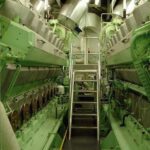Energy News Beat
Andrew Craig-Bennett warns about the risks of using prevalent knock-off spare parts.
When a new ship leaves her builder for her maiden voyage, she will carry spare parts. We can probably – probably – assume that these spare parts, as well as the renewable and consumable components fitted in her mechanical and electrical systems, are genuine manufacturers’ items.
I write ‘probably’ because the purchasing department is the profit centre in every shipyard that I know of, and some shipyard purchasing departments contain rather sharp characters. But let’s assume that the ship sets out in life with genuine spares onboard.
This happy situation is unlikely to continue through the life of the ship. Our industry is absolutely infested with fakes, and we don’t care.
Some readers may feel that the word fake is too strong and they would rather talk about pattern spares, secondary market spares, grey market spares and, particularly iniquitous, OEM spares.
They are all fakes. And pretty much every seagoing engineer is engaged in a quiet battle with his own office and his own superintendents. Deck officers too, because there are fake spares for cranes, winches and especially hatch covers. This sort of thing goes on in the most admired shipowning companies as well as in the less reputable ones.
The term OEM” means, of course, “Original Equipment Maker”. As a young man obsessed with motorcycles I asked my local motorbike shop for a new battery for a BMW bike. I knew the man I was talking to quite well (as one does) and he said: “Well, I can offer you two – here’s the BMW one (naming a price beyond the dreams of avarice – I think it was £70) or here’s the pattern spare (a third of the price). He went on: “If you look carefully at the plastic casing, you will see that the moulding marks are exactly the same!”
I bought the pattern spare, of course. It had certainly come off the same production line as Bavarian Motor Works’ far more expensive battery and of course I thought no further than BMW are ripping their customers off. Now, I know better.
A friend, of the engineering persuasion, has a hierarchy of spares and I’m going to quote his email to me:
“In my experience these come in several types: Those manufactured by a third party but packaged identically to the genuine article – very difficult to tell until they fail. Copy spares manufactured to the correct specification under licence or even, once the original manufacturer has ceased trading to the original drawings – I have no problem with these and they frequently enable vessels to keep trading – spares for Titan separators and Malone pnumercators being two cases in point. We now come to the more dangerous spares, those marketed as OEM replacements but not fulfilling the original requirements.”
At this point he gave as a prime example consumable spares for an extremely well known make of purifiers. Since everyone can guess the name I will leave you to do so.
“There are a number of suppliers who make spares under licence for the original manufacturer / licensee, normally whilst these are being manufactured the original maker maintains a presence for quality control,” he wrote, adding: “Some of these manufacturers take advantage of having the proper drawings / specifications and produce extra ‘unofficial’ items. The (a ship we both remember) had a Sulzer engine and “X” sourced new liners from one of these manufacturers, sadly the material specification was not followed leading to rapid bore wear.”
The conversation was started by my reminiscing about a set of generator valve springs which were indeed manufactured by the original maker, using indeed the correct material, but a part of the heat treatment had been skipped. That proved very expensive…
Would you be happy to fly in an aircraft with pattern spares fitted? You would not, but you probably just said to yourself “Well, that’s aviation.. they are different”
If (another case cited by my friend, in the engine room of a ship that I had ordered) a turbocharger explodes because the impeller contacts the volute, a consequence of the licensee (a very famous Japanese company) having substituted a non-creep-resistant material for the originally specified material, how safe is that? How safe is a purifier seal failure?
What we have here is yet another case of, “It’s always been like this” and “How can you do anything about it?”
Well, here’s a suggestion. How do you check if the Hours of Rest have been “flogged”? By comparing the Hours of Rest record with the Bell Book. (Yes, of course the thinking officer now writes up the Hours of Rest fiction with the Bell Book open in front of her or him).
Do the same thing with the spares purchasing accounts – pick a couple of items and check against the real maker’s prices. Or (radical idea, I know) talk to your engineers.
The post Any old spares? appeared first on Energy News Beat.









